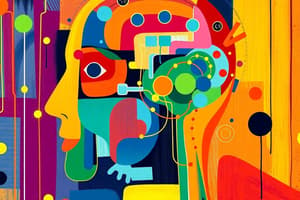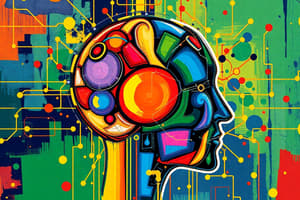Podcast
Questions and Answers
What distinguishes supervised learning from unsupervised learning?
What distinguishes supervised learning from unsupervised learning?
- Supervised learning involves algorithms that learn from unstructured data.
- Unsupervised learning uses labeled training data to teach the algorithm.
- Unsupervised learning focuses on making predictions about future data.
- Supervised learning requires labeled data to map inputs to outputs. (correct)
Which of the following statements about deep learning is true?
Which of the following statements about deep learning is true?
- Feedforward networks allow information to flow in loops.
- Convolutional neural networks are designed for purely sequential data.
- Deep learning is inspired by the structure and function of the human brain. (correct)
- Deep learning models have a single layer of neurons.
Which application is specifically associated with computer vision?
Which application is specifically associated with computer vision?
- Predictive modeling for sales forecasting.
- Reinforcement learning for decision making.
- Natural Language Processing for text analysis.
- Image segmentation for dividing images into regions. (correct)
What is a characteristic feature of convolutional neural networks (CNNs)?
What is a characteristic feature of convolutional neural networks (CNNs)?
In reinforcement learning, how does the algorithm learn?
In reinforcement learning, how does the algorithm learn?
What is an example of object detection in computer vision?
What is an example of object detection in computer vision?
Which type of deep learning model allows information to flow in a loop?
Which type of deep learning model allows information to flow in a loop?
What are the primary uses of machine learning applications?
What are the primary uses of machine learning applications?
Flashcards are hidden until you start studying
Study Notes
Machine Learning
- A subset of AI that involves training algorithms to learn from data and make predictions or decisions
- Types of Machine Learning:
- Supervised Learning: Training data is labeled, and the algorithm learns to map inputs to outputs
- Unsupervised Learning: Training data is unlabeled, and the algorithm learns to identify patterns or structure
- Reinforcement Learning: Algorithm learns through trial and error, receiving rewards or penalties for its actions
- Machine Learning applications:
- Image and speech recognition
- Natural Language Processing (NLP)
- Predictive modeling and analytics
- Recommendation systems
Deep Learning
- A subset of Machine Learning that involves the use of artificial neural networks with multiple layers
- Inspired by the structure and function of the human brain
- Types of Deep Learning models:
- Feedforward Networks: Information flows only in one direction, from input layer to output layer
- Recurrent Neural Networks (RNNs): Information can flow in a loop, allowing the model to keep track of state
- Convolutional Neural Networks (CNNs): Designed for image and signal processing, using convolutional and pooling layers
- Deep Learning applications:
- Image recognition and object detection
- Natural Language Processing (NLP) and language translation
- Speech recognition and generation
- Game playing and decision making
Computer Vision
- A field of study focused on enabling computers to interpret and understand visual information from the world
- Involves developing algorithms and models that can process and analyze visual data from images and videos
- Computer Vision applications:
- Image Classification: Assigning labels or categories to images
- Object Detection: Identifying and locating objects within images
- Image Segmentation: Dividing images into regions of interest
- Scene Understanding: Interpreting the meaning and context of visual scenes
- Computer Vision is used in:
- Self-driving cars and autonomous systems
- Surveillance and security systems
- Healthcare and medical imaging
- Robotics and human-computer interaction
Machine Learning
- Trains algorithms to learn from data and make predictions or decisions
- Supervised Learning: Labeled training data, algorithm learns to map inputs to outputs
- Unsupervised Learning: Unlabeled training data, algorithm identifies patterns or structure
- Reinforcement Learning: Algorithm learns through trial and error, receiving rewards or penalties
- Applications: image and speech recognition, natural language processing, predictive modeling, and recommendation systems
Deep Learning
- Uses artificial neural networks with multiple layers
- Inspired by human brain structure and function
- Feedforward Networks: Information flows one direction, input to output layer
- Recurrent Neural Networks (RNNs): Information flows in a loop, tracking state
- Convolutional Neural Networks (CNNs): Designed for image and signal processing
- Applications: image recognition, object detection, natural language processing, speech recognition, and game playing
Computer Vision
- Enables computers to interpret and understand visual information
- Develops algorithms to process and analyze visual data from images and videos
- Image Classification: Assigns labels or categories to images
- Object Detection: Identifies and locates objects within images
- Image Segmentation: Divides images into regions of interest
- Scene Understanding: Interprets meaning and context of visual scenes
- Applications: self-driving cars, surveillance, healthcare, robotics, and human-computer interaction
Studying That Suits You
Use AI to generate personalized quizzes and flashcards to suit your learning preferences.




